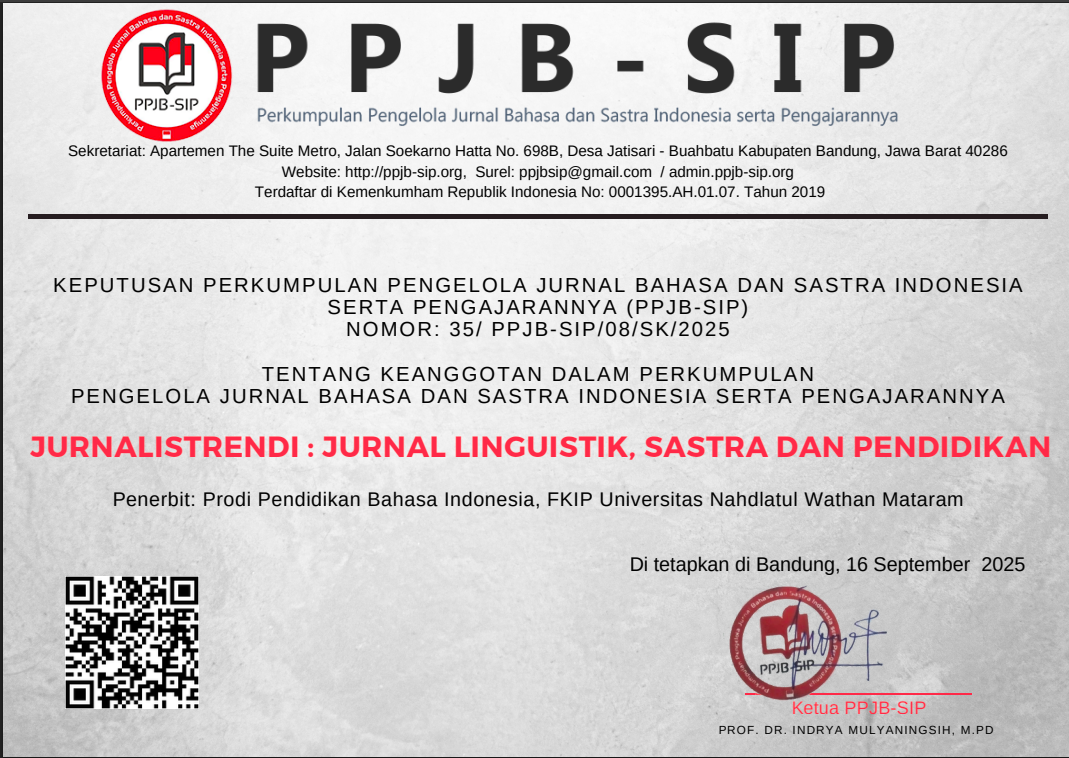Afiksasi Verba Bahasa Sunda dan Indonesia pada Cerpen “Stiker Hemat Energi”
Abstract
The research was conducted to anticipate the problems encountered by learners in learning B-2. The data in the study came from a Sundanese textbook entitled "Basa Sunda Urang" by Tatang Sumarsono (2017). This research technique uses content analysis techniques to identify the form of Sundanese and Indonesian verb affixation in the short story "Energy Saving Stickers" and uses documentation study techniques related to the theory of contrastive and morphological analysis. The results show that there are similarities and differences in the forms of verb affixation in Sundanese and Indonesian. The similarity of verb affixation forms in Sundanese and Indonesian, namely prefix {di-} in Sundanese with prefix {di-} in Indonesian; confix {di-...-keun} in Sundanese with confix {di-.... -kan} in Indonesian; the confixes {nga-...-keun}, {ny-...-keun}, and {n-...-keun} in Sundanese with the confix {me(N)-...-kan} in Indonesian; and the confix {nga-...-na} in Sundanese with the confix {me(N)-...-nya} in Indonesian. The similarity between the meaning of Sundanese and Indonesian verb affixes, namely the suffix {-keun + -eun} in Sundanese with the confix {di-...-kan} in Indonesian and the confix {di-...-keun} in Sundanese with the confix {di-...-kan} in Indonesian, these two affixes both form the meaning of passive verbs which means ‘doing passive actions’. In this study, it can also be seen that in Sundanese and Indonesian there are similarities or similarities in the basic form class, namely the use of nouns, verbs, and adjectives.
Downloads
References
Chaer, A. (2007). Linguistik Umum. Jakarta: Rineka Cipta.
Chaer, A. (2004). Sosiolinguistik Pengenalan Awal. Jakarta: Rineka Cipta.
Fisher, M., Triwasih, & Cherly, S. (2014). Sari Kata Bahasa Indonesia dan EYD. Jakarta: Lembar Langit Indonesia.
Kemendikbud. (2016). Kamus Besar Bahasa Indonesia Edisi Digital.
Muslich, M. (2008). Tata Bentuk Bahasa Indonesia, Kajian kearah tata bahasa deskriptif. Jakarta: Bumi Aksara.
Rosidin, O. (2015). Percikan Linguistik: Pengantar Memahami Ilmu Bahasa. Serang: Untirta Press.
Ramlan. (2009). Morfologi: Suatu Tinjauan Deskriptif. Yogyakarta: Karyono.
Sitorus, J. P. (2019). Mengenal Tata Bahasa Indonesia. Malang: CV Eventry.
Sumarsono, T. (2017). Basa Sunda Urang. Bandung: CV Geger Sunten.
Sugiyono. (2016). Metode Penelitian Kuantitatif, Kualitatif, dan R&D. Bandung: Alfabeta.
Usliani, Quthny, A. Y. A., & Hamdiyah, M. (2023). Proses Morfologi Bahasa Madura Dialek Gili Ketapang Kecamatan Sumberasih Kabupaten Probolinggo. Dalam Jurnalistrendi: Jurnal Linguistik, Sastra, dan Pendidikan, Volume 8, Nomor 1, April 2023, hlm. 42-49.
Munandar, Y. (2016). Afiks Pembentuk Verba Bahasa Sunda. Dalam Jurnal Humanika, Volume 16, Nomor 1, Maret 2016.
Romli, M., & Wildan, M. (2015). Afiksasi Dalam Bahasa Indonesia dan Bahasa Sunda (Studi Kontrastif). Dalam Jurnal Sasindo Unpam, Volume 2, Nomor 2, Juli 2015, hlm. 1-9.
Yuliani, Y., Rosidin, O., & Devi, A. A. K. (2022). Kajian Analisis Kontrastif: Afiksasi Verba Bahasa Jawa Cilegon dengan Bahasa Indonesia. Dalam Pena Literasi: Jurnal Pendidikan Bahasa dan Sastra Indonesia, Oktober 2022, hlm. 209-219.
Permendikbudridtek 2022 No. 7, Standar Isi Pada Pendidikan Anak Usia Dini, Jenjang Pendidikan Dasar, dan Jenjang Pendidikan Menengah.
Undang-undang Republik Indonesia 2003 No. 20, Sistem Pendidikan Nasional.

.jpg)





